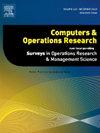Drone-aided mobile blood collection problem: A rolling-horizon-based matheuristic
IF 4.3
2区 工程技术
Q2 COMPUTER SCIENCE, INTERDISCIPLINARY APPLICATIONS
引用次数: 0
Abstract
This study introduces the drone-aided mobile blood collection problem, which integrates mobile blood donation vehicles with drones to improve operations related to the blood collection in urban areas. Each vehicle, carrying multiple drones, travels to several collection sites to conduct blood collection operations within a working day. Drones fly between vehicles to pick up collected blood bags and deliver them to the blood center. This collaborative framework enhances the performances of the collection system and ensures the freshness of collected blood upon arrival to the blood center. We develop a novel mixed-integer linear programming model to optimally synchronize the routes and collection schedules of mobile units and drones to ensure the timely delivery of collected blood to the blood center. We also develop a rolling-horizon-based matheuristic to solve large-scale instances of the problem. This algorithm combines a rolling horizon approach, which divides the problem into manageable subproblems solved sequentially, with a local branching technique that enhances solutions by exploring promising neighborhoods. To evaluate the algorithm’s performance, we conduct a comprehensive computational study. Our results show that the proposed algorithm not only finds better solutions than those obtained by Gurobi but also outperforms other matheuristics, including the rolling horizon, relax-and-fix, and fix-and-optimize algorithms. Finally, we demonstrate the real-life applicability of the problem through a case study in Quebec City, Canada.
无人机辅助移动采血问题:基于滚动水平的数学
本研究介绍了无人机辅助移动采血问题,将移动献血车与无人机相结合,改善城市地区采血相关操作。每辆车携带多架无人机,在一个工作日内前往多个采血点进行采血作业。无人机在车辆之间飞行,收集血袋并将其运送到血液中心。这种协作框架提高了采集系统的性能,并确保采集的血液到达血液中心后的新鲜度。我们开发了一种新的混合整数线性规划模型,以优化同步移动单元和无人机的路线和采集时间表,以确保采集的血液及时送到血液中心。我们还开发了一种基于滚动水平的数学方法来解决大规模实例问题。该算法结合了滚动地平线方法和局部分支技术,前者将问题划分为可管理的子问题,然后依次解决,通过探索有希望的邻域来增强解决方案。为了评估算法的性能,我们进行了全面的计算研究。我们的研究结果表明,所提出的算法不仅比Gurobi得到的解更好,而且优于其他数学算法,包括滚动地平线,松弛和修复以及修复和优化算法。最后,我们通过加拿大魁北克市的一个案例研究来证明该问题在现实生活中的适用性。
本文章由计算机程序翻译,如有差异,请以英文原文为准。
求助全文
约1分钟内获得全文
求助全文
来源期刊

Computers & Operations Research
工程技术-工程:工业
CiteScore
8.60
自引率
8.70%
发文量
292
审稿时长
8.5 months
期刊介绍:
Operations research and computers meet in a large number of scientific fields, many of which are of vital current concern to our troubled society. These include, among others, ecology, transportation, safety, reliability, urban planning, economics, inventory control, investment strategy and logistics (including reverse logistics). Computers & Operations Research provides an international forum for the application of computers and operations research techniques to problems in these and related fields.
 求助内容:
求助内容: 应助结果提醒方式:
应助结果提醒方式:


